Analysis of Carly Case Study: Empathy Gaps and Communication Skills
VerifiedAdded on 2022/10/03
|10
|1129
|375
Case Study
AI Summary
This case study examines Carly's challenging circumstances, highlighting empathy gaps stemming from domestic violence, sexual, physical, and emotional abuse, along with substance abuse and mental health issues. Carly's history includes drug use, suicidal ideation, and involvement in dangerous situations. The analysis explores perception biases related to her experiences, emphasizing the impact of grief, lack of support, and societal judgment. The study also emphasizes the importance of communication skills, such as active listening, paraphrasing, reflection of feelings, and commiseration, to foster empathy and provide effective support. These skills are crucial for helping individuals like Carly overcome their struggles and find healing. The case underscores the need for compassion, respect, and acceptance to address the complex challenges faced by individuals with similar experiences.
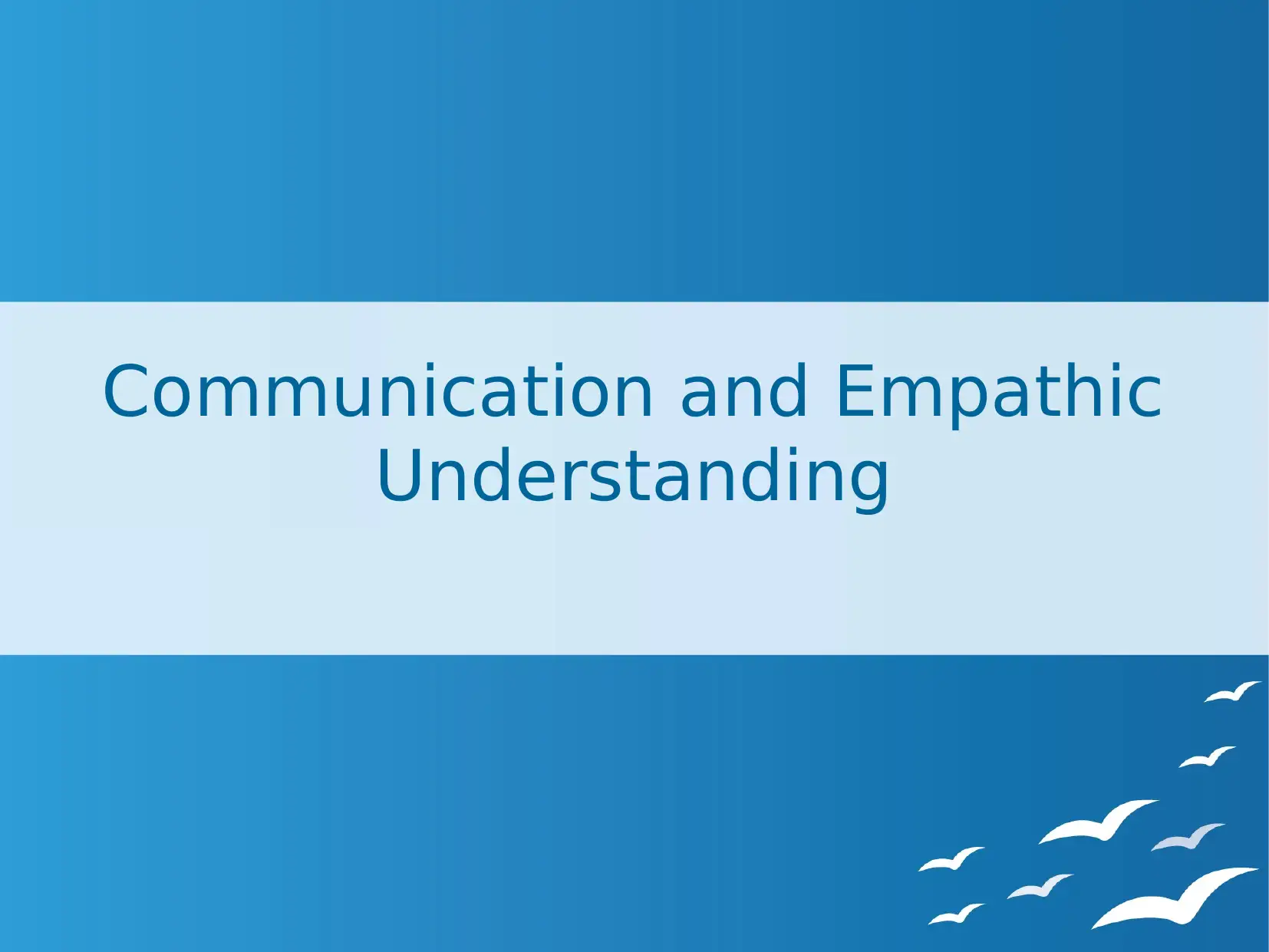
Communication and Empathic
Understanding
Understanding
Paraphrase This Document
Need a fresh take? Get an instant paraphrase of this document with our AI Paraphraser
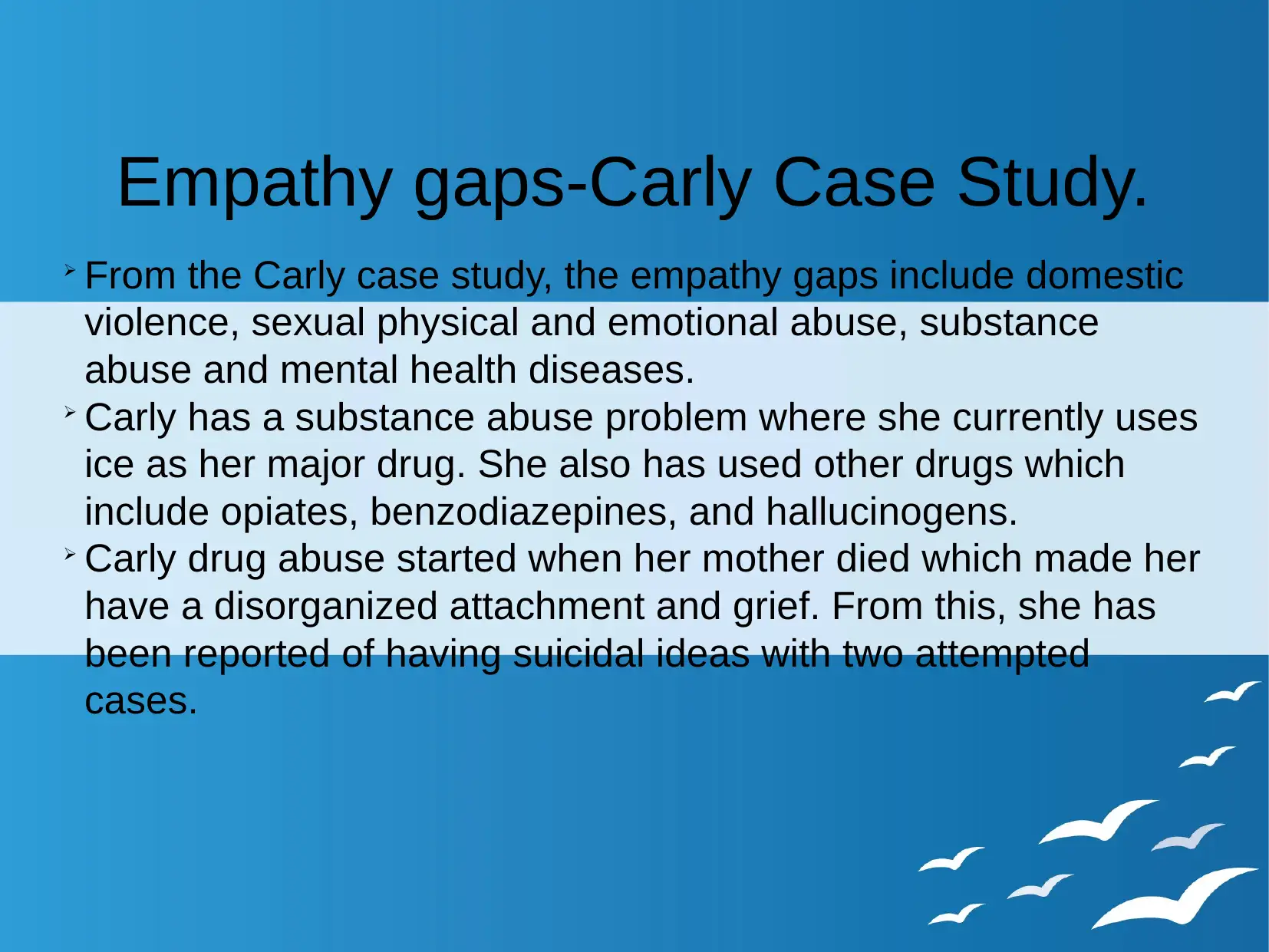
Empathy gaps-Carly Case Study.
From the Carly case study, the empathy gaps include domestic
violence, sexual physical and emotional abuse, substance
abuse and mental health diseases.
Carly has a substance abuse problem where she currently uses
ice as her major drug. She also has used other drugs which
include opiates, benzodiazepines, and hallucinogens.
Carly drug abuse started when her mother died which made her
have a disorganized attachment and grief. From this, she has
been reported of having suicidal ideas with two attempted
cases.
From the Carly case study, the empathy gaps include domestic
violence, sexual physical and emotional abuse, substance
abuse and mental health diseases.
Carly has a substance abuse problem where she currently uses
ice as her major drug. She also has used other drugs which
include opiates, benzodiazepines, and hallucinogens.
Carly drug abuse started when her mother died which made her
have a disorganized attachment and grief. From this, she has
been reported of having suicidal ideas with two attempted
cases.
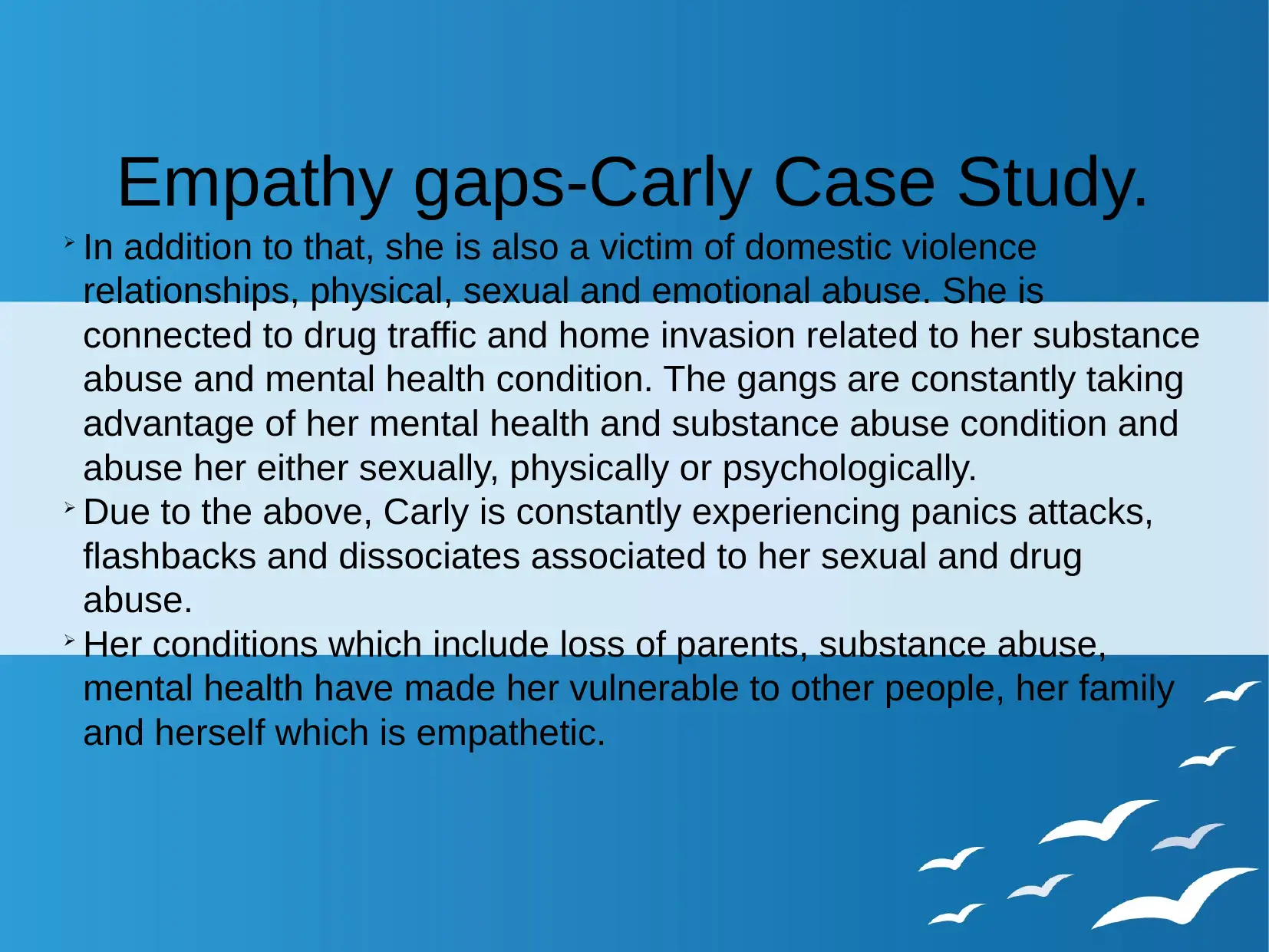
Empathy gaps-Carly Case Study.
In addition to that, she is also a victim of domestic violence
relationships, physical, sexual and emotional abuse. She is
connected to drug traffic and home invasion related to her substance
abuse and mental health condition. The gangs are constantly taking
advantage of her mental health and substance abuse condition and
abuse her either sexually, physically or psychologically.
Due to the above, Carly is constantly experiencing panics attacks,
flashbacks and dissociates associated to her sexual and drug
abuse.
Her conditions which include loss of parents, substance abuse,
mental health have made her vulnerable to other people, her family
and herself which is empathetic.
In addition to that, she is also a victim of domestic violence
relationships, physical, sexual and emotional abuse. She is
connected to drug traffic and home invasion related to her substance
abuse and mental health condition. The gangs are constantly taking
advantage of her mental health and substance abuse condition and
abuse her either sexually, physically or psychologically.
Due to the above, Carly is constantly experiencing panics attacks,
flashbacks and dissociates associated to her sexual and drug
abuse.
Her conditions which include loss of parents, substance abuse,
mental health have made her vulnerable to other people, her family
and herself which is empathetic.
⊘ This is a preview!⊘
Do you want full access?
Subscribe today to unlock all pages.

Trusted by 1+ million students worldwide
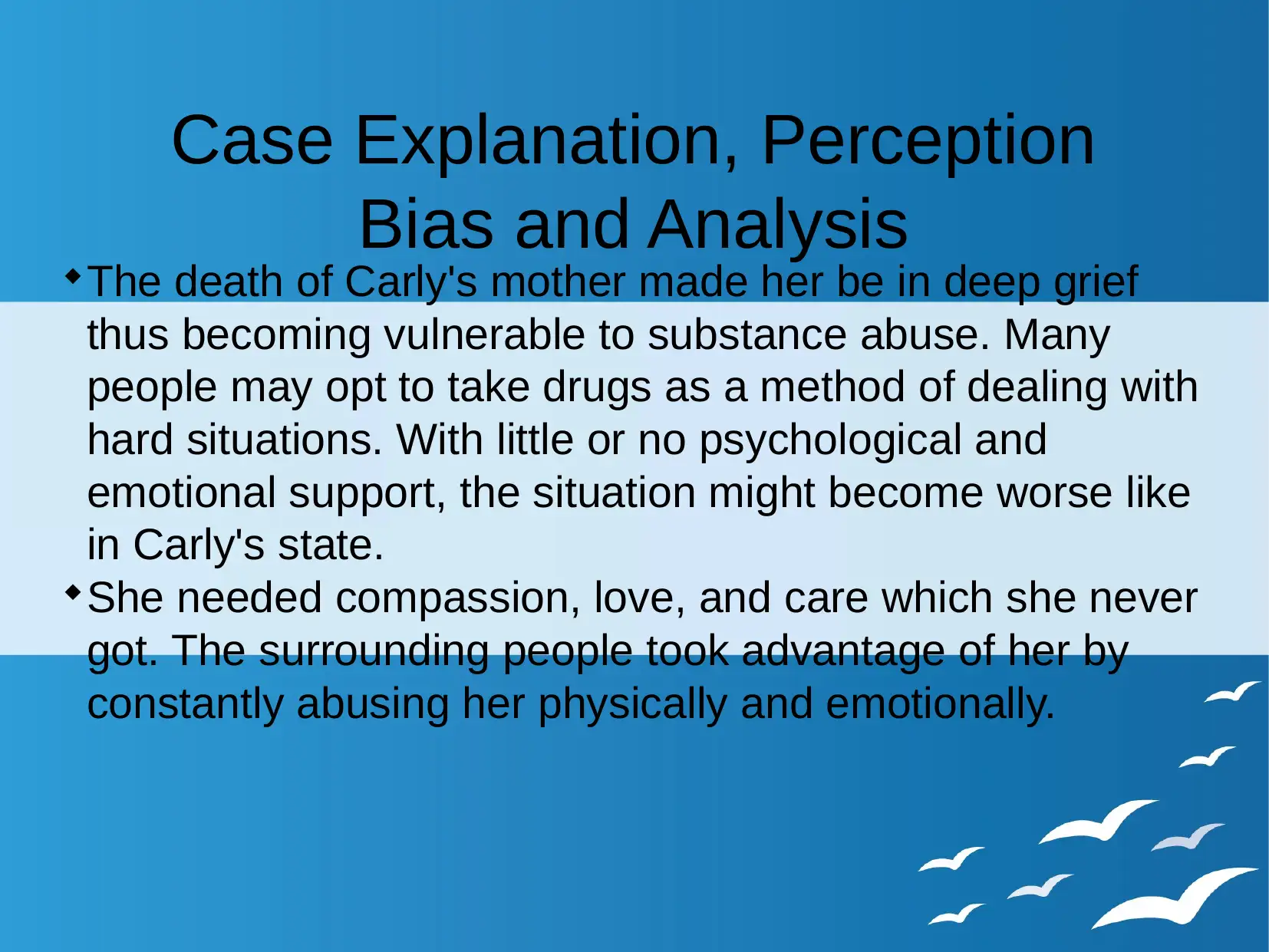
Case Explanation, Perception
Bias and Analysis
The death of Carly's mother made her be in deep grief
thus becoming vulnerable to substance abuse. Many
people may opt to take drugs as a method of dealing with
hard situations. With little or no psychological and
emotional support, the situation might become worse like
in Carly's state.
She needed compassion, love, and care which she never
got. The surrounding people took advantage of her by
constantly abusing her physically and emotionally.
Bias and Analysis
The death of Carly's mother made her be in deep grief
thus becoming vulnerable to substance abuse. Many
people may opt to take drugs as a method of dealing with
hard situations. With little or no psychological and
emotional support, the situation might become worse like
in Carly's state.
She needed compassion, love, and care which she never
got. The surrounding people took advantage of her by
constantly abusing her physically and emotionally.
Paraphrase This Document
Need a fresh take? Get an instant paraphrase of this document with our AI Paraphraser
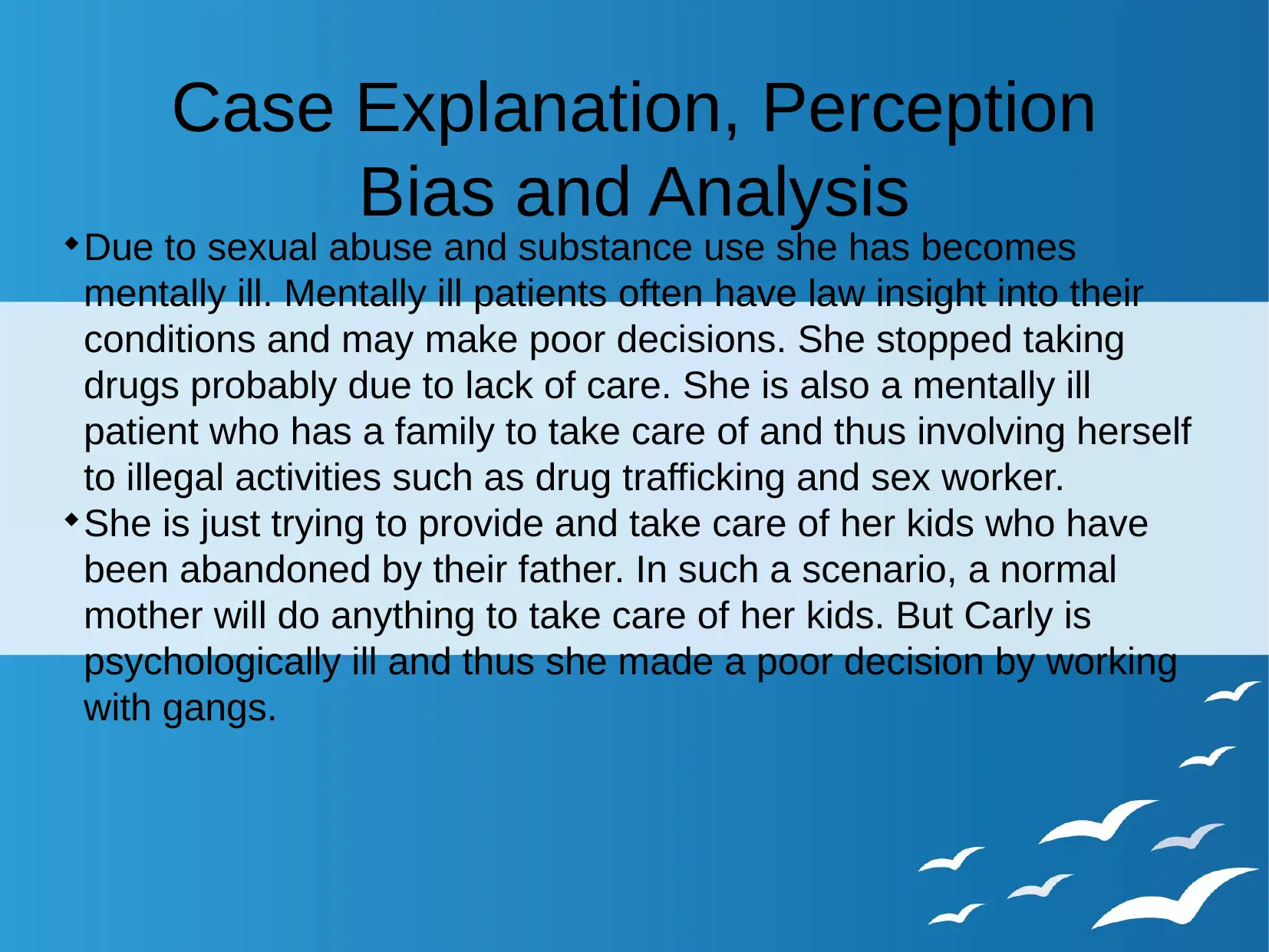
Case Explanation, Perception
Bias and Analysis Due to sexual abuse and substance use she has becomes
mentally ill. Mentally ill patients often have law insight into their
conditions and may make poor decisions. She stopped taking
drugs probably due to lack of care. She is also a mentally ill
patient who has a family to take care of and thus involving herself
to illegal activities such as drug trafficking and sex worker.
She is just trying to provide and take care of her kids who have
been abandoned by their father. In such a scenario, a normal
mother will do anything to take care of her kids. But Carly is
psychologically ill and thus she made a poor decision by working
with gangs.
Bias and Analysis Due to sexual abuse and substance use she has becomes
mentally ill. Mentally ill patients often have law insight into their
conditions and may make poor decisions. She stopped taking
drugs probably due to lack of care. She is also a mentally ill
patient who has a family to take care of and thus involving herself
to illegal activities such as drug trafficking and sex worker.
She is just trying to provide and take care of her kids who have
been abandoned by their father. In such a scenario, a normal
mother will do anything to take care of her kids. But Carly is
psychologically ill and thus she made a poor decision by working
with gangs.
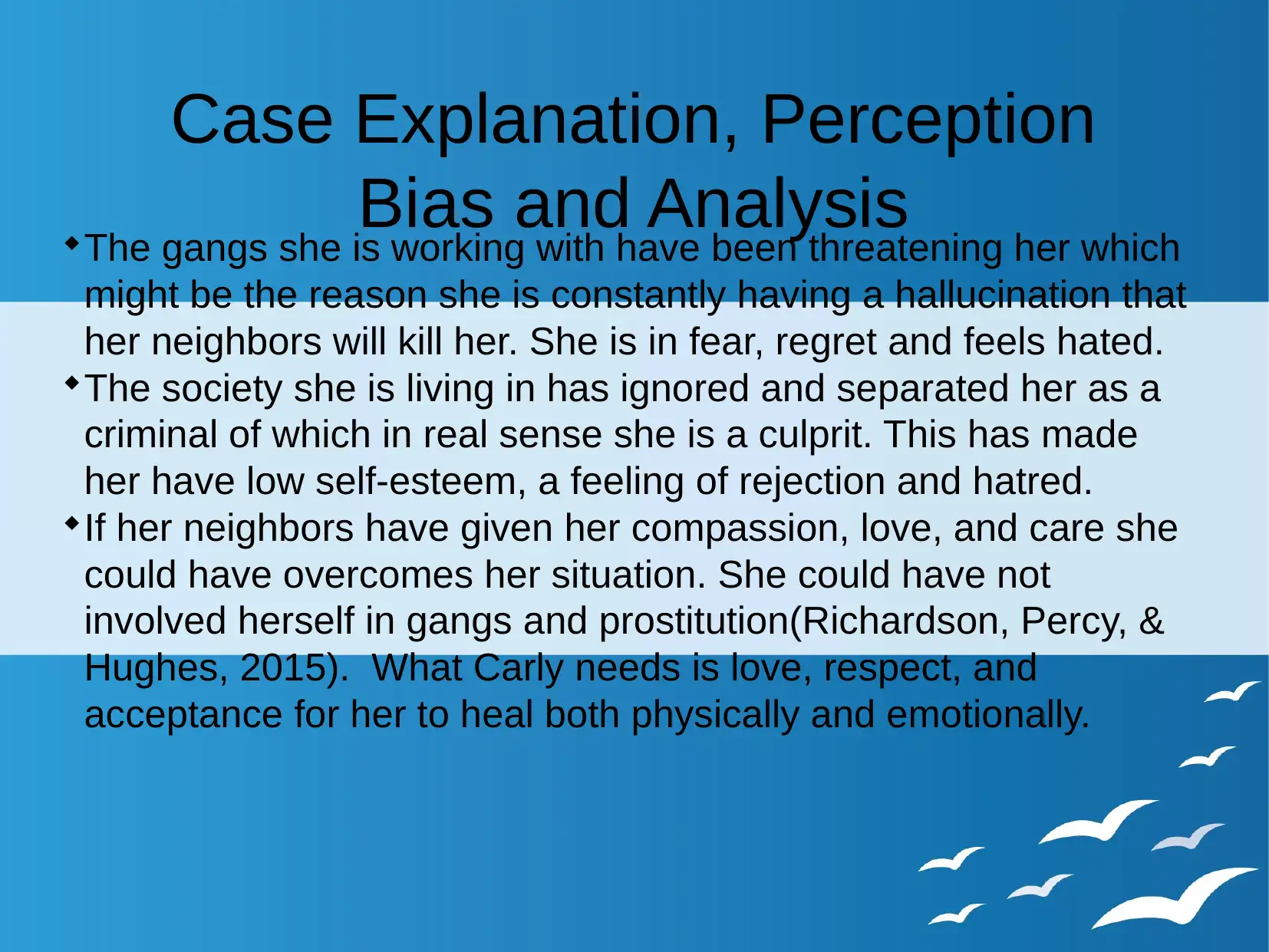
Case Explanation, Perception
Bias and Analysis The gangs she is working with have been threatening her which
might be the reason she is constantly having a hallucination that
her neighbors will kill her. She is in fear, regret and feels hated.
The society she is living in has ignored and separated her as a
criminal of which in real sense she is a culprit. This has made
her have low self-esteem, a feeling of rejection and hatred.
If her neighbors have given her compassion, love, and care she
could have overcomes her situation. She could have not
involved herself in gangs and prostitution(Richardson, Percy, &
Hughes, 2015). What Carly needs is love, respect, and
acceptance for her to heal both physically and emotionally.
Bias and Analysis The gangs she is working with have been threatening her which
might be the reason she is constantly having a hallucination that
her neighbors will kill her. She is in fear, regret and feels hated.
The society she is living in has ignored and separated her as a
criminal of which in real sense she is a culprit. This has made
her have low self-esteem, a feeling of rejection and hatred.
If her neighbors have given her compassion, love, and care she
could have overcomes her situation. She could have not
involved herself in gangs and prostitution(Richardson, Percy, &
Hughes, 2015). What Carly needs is love, respect, and
acceptance for her to heal both physically and emotionally.
⊘ This is a preview!⊘
Do you want full access?
Subscribe today to unlock all pages.

Trusted by 1+ million students worldwide
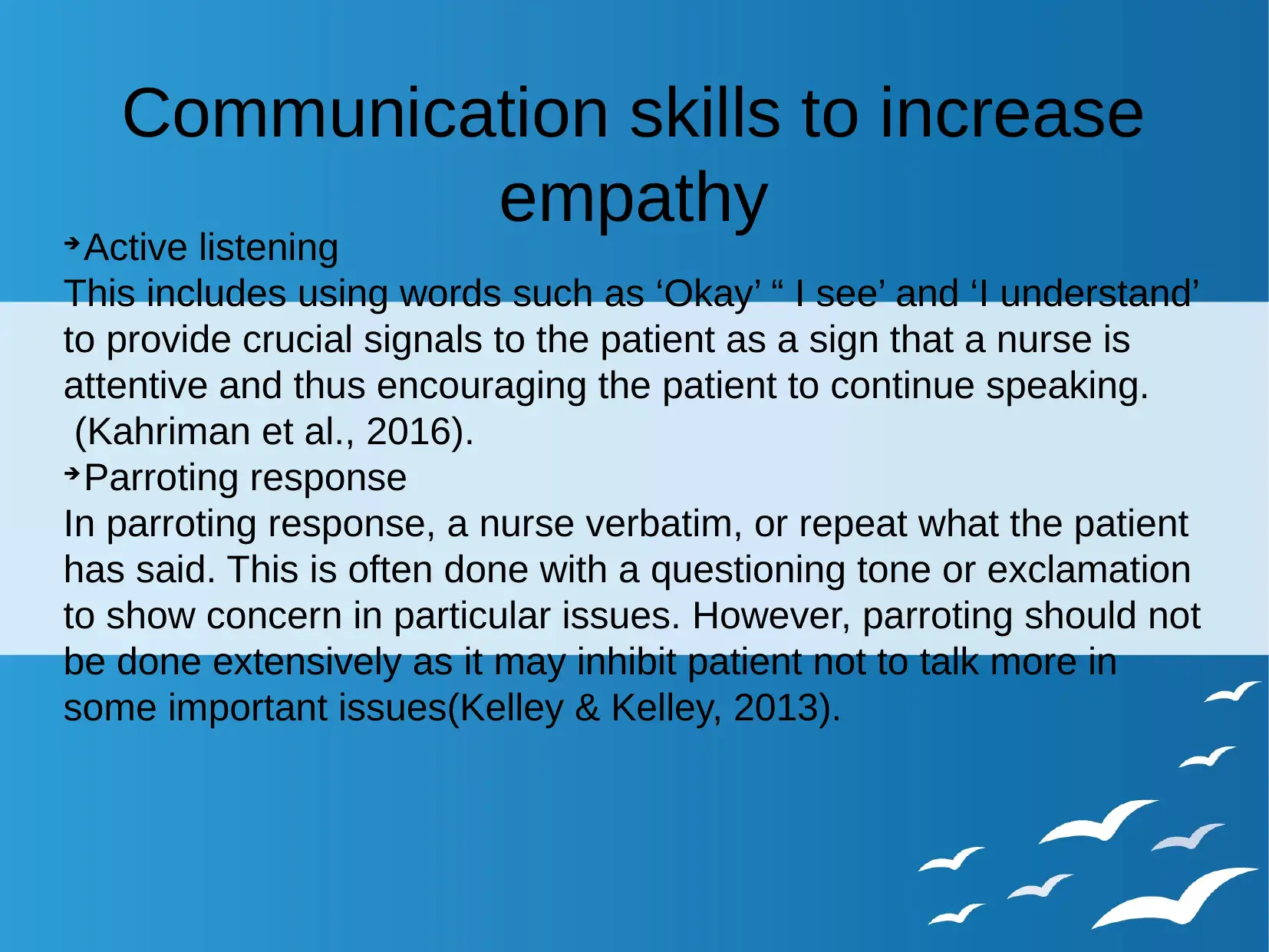
Communication skills to increase
empathy Active listening
This includes using words such as ‘Okay’ “ I see’ and ‘I understand’
to provide crucial signals to the patient as a sign that a nurse is
attentive and thus encouraging the patient to continue speaking.
(Kahriman et al., 2016).
Parroting response
In parroting response, a nurse verbatim, or repeat what the patient
has said. This is often done with a questioning tone or exclamation
to show concern in particular issues. However, parroting should not
be done extensively as it may inhibit patient not to talk more in
some important issues(Kelley & Kelley, 2013).
empathy Active listening
This includes using words such as ‘Okay’ “ I see’ and ‘I understand’
to provide crucial signals to the patient as a sign that a nurse is
attentive and thus encouraging the patient to continue speaking.
(Kahriman et al., 2016).
Parroting response
In parroting response, a nurse verbatim, or repeat what the patient
has said. This is often done with a questioning tone or exclamation
to show concern in particular issues. However, parroting should not
be done extensively as it may inhibit patient not to talk more in
some important issues(Kelley & Kelley, 2013).
Paraphrase This Document
Need a fresh take? Get an instant paraphrase of this document with our AI Paraphraser
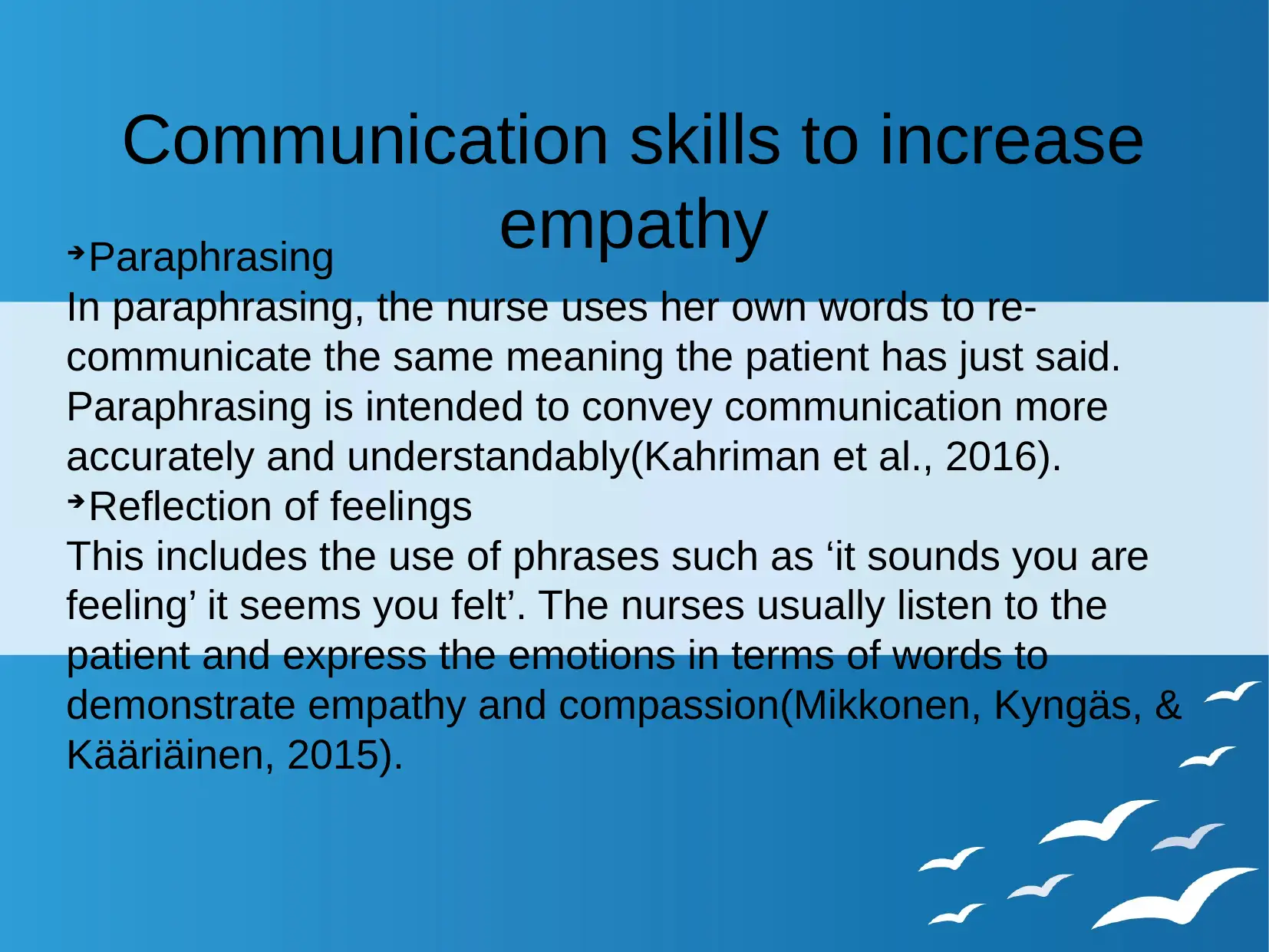
Communication skills to increase
empathy Paraphrasing
In paraphrasing, the nurse uses her own words to re-
communicate the same meaning the patient has just said.
Paraphrasing is intended to convey communication more
accurately and understandably(Kahriman et al., 2016).
Reflection of feelings
This includes the use of phrases such as ‘it sounds you are
feeling’ it seems you felt’. The nurses usually listen to the
patient and express the emotions in terms of words to
demonstrate empathy and compassion(Mikkonen, Kyngäs, &
Kääriäinen, 2015).
empathy Paraphrasing
In paraphrasing, the nurse uses her own words to re-
communicate the same meaning the patient has just said.
Paraphrasing is intended to convey communication more
accurately and understandably(Kahriman et al., 2016).
Reflection of feelings
This includes the use of phrases such as ‘it sounds you are
feeling’ it seems you felt’. The nurses usually listen to the
patient and express the emotions in terms of words to
demonstrate empathy and compassion(Mikkonen, Kyngäs, &
Kääriäinen, 2015).
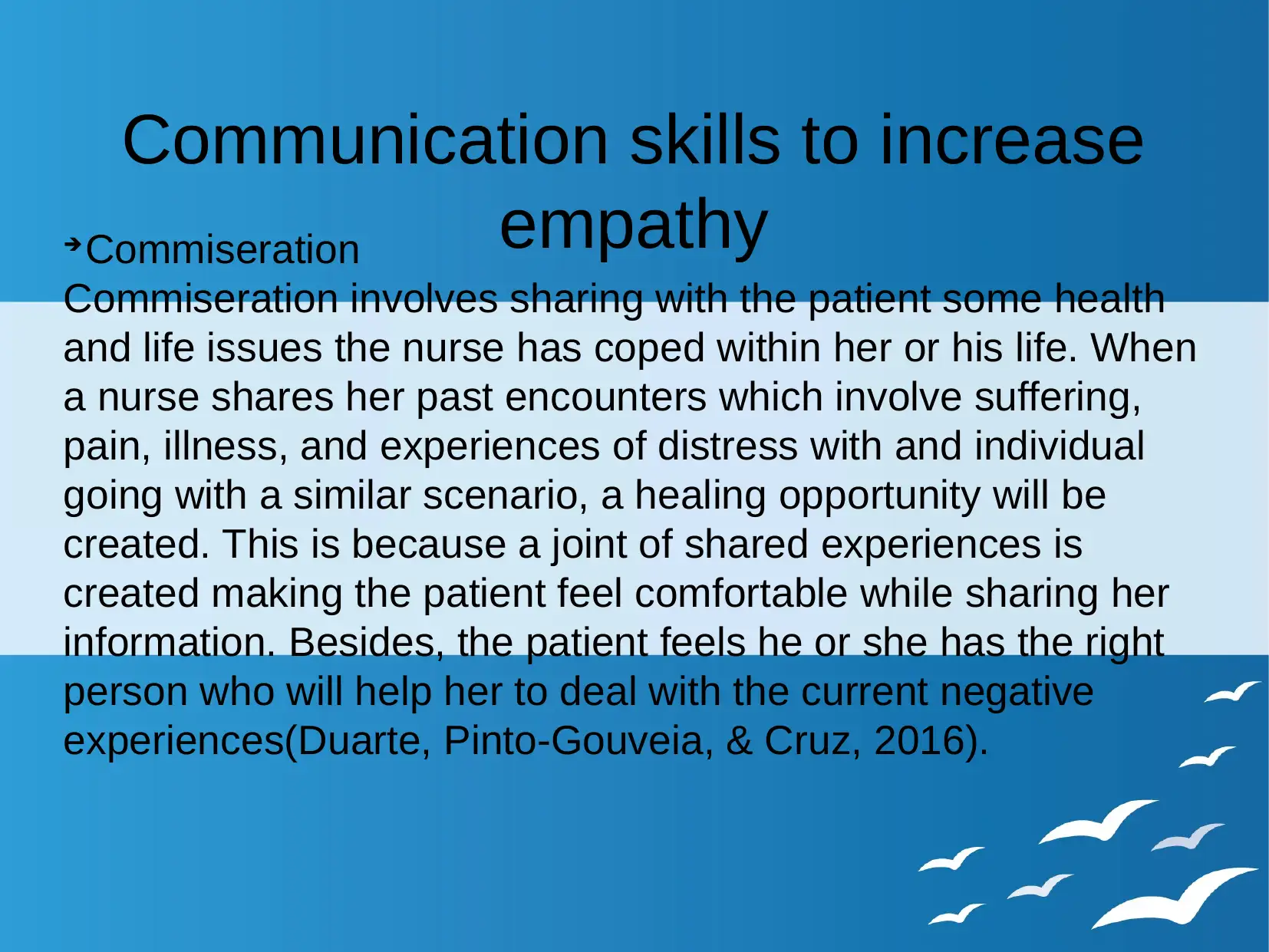
Communication skills to increase
empathy Commiseration
Commiseration involves sharing with the patient some health
and life issues the nurse has coped within her or his life. When
a nurse shares her past encounters which involve suffering,
pain, illness, and experiences of distress with and individual
going with a similar scenario, a healing opportunity will be
created. This is because a joint of shared experiences is
created making the patient feel comfortable while sharing her
information. Besides, the patient feels he or she has the right
person who will help her to deal with the current negative
experiences(Duarte, Pinto-Gouveia, & Cruz, 2016).
empathy Commiseration
Commiseration involves sharing with the patient some health
and life issues the nurse has coped within her or his life. When
a nurse shares her past encounters which involve suffering,
pain, illness, and experiences of distress with and individual
going with a similar scenario, a healing opportunity will be
created. This is because a joint of shared experiences is
created making the patient feel comfortable while sharing her
information. Besides, the patient feels he or she has the right
person who will help her to deal with the current negative
experiences(Duarte, Pinto-Gouveia, & Cruz, 2016).
⊘ This is a preview!⊘
Do you want full access?
Subscribe today to unlock all pages.

Trusted by 1+ million students worldwide
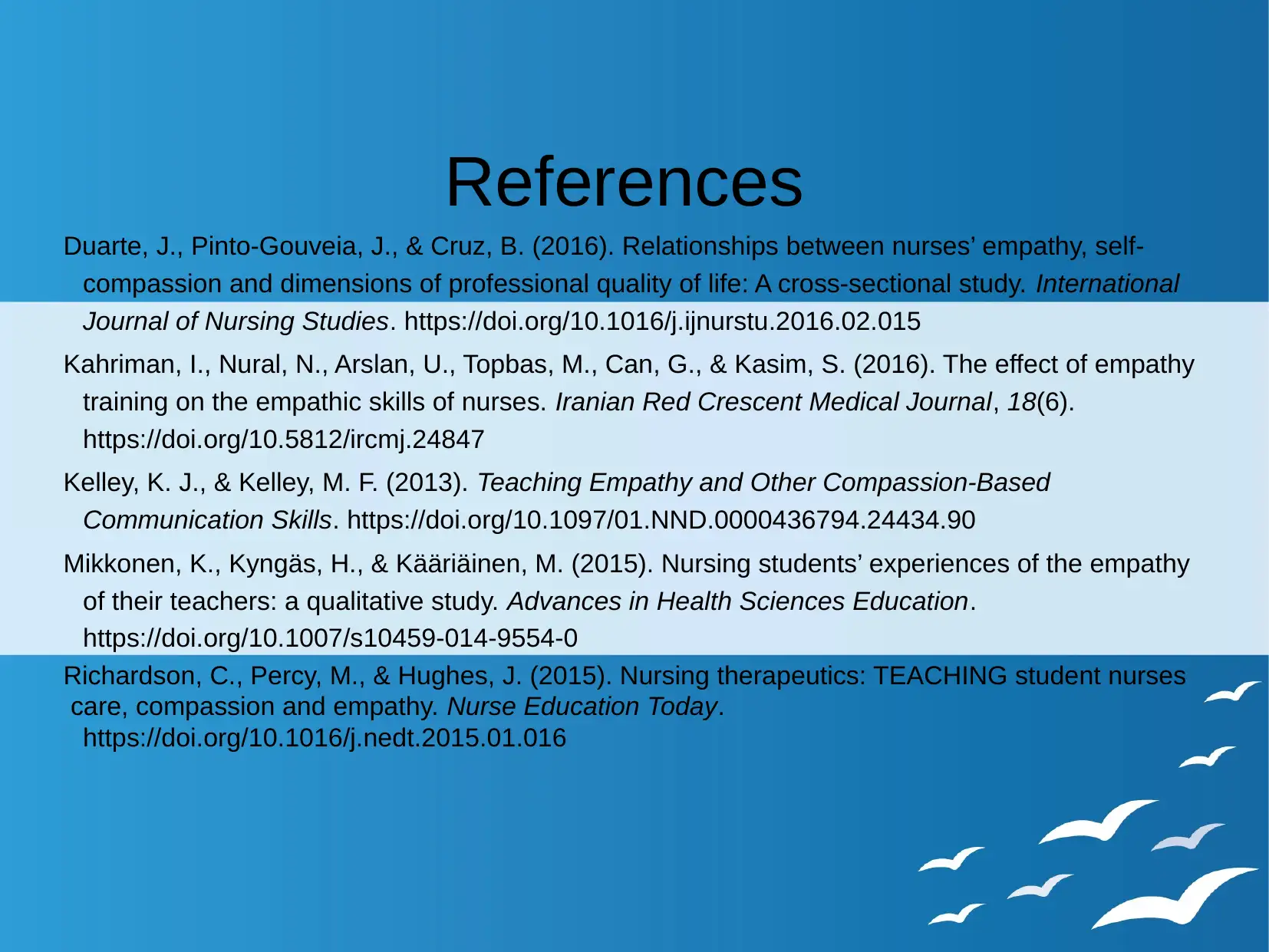
References
Duarte, J., Pinto-Gouveia, J., & Cruz, B. (2016). Relationships between nurses’ empathy, self-
compassion and dimensions of professional quality of life: A cross-sectional study. International
Journal of Nursing Studies. https://doi.org/10.1016/j.ijnurstu.2016.02.015
Kahriman, I., Nural, N., Arslan, U., Topbas, M., Can, G., & Kasim, S. (2016). The effect of empathy
training on the empathic skills of nurses. Iranian Red Crescent Medical Journal, 18(6).
https://doi.org/10.5812/ircmj.24847
Kelley, K. J., & Kelley, M. F. (2013). Teaching Empathy and Other Compassion-Based
Communication Skills. https://doi.org/10.1097/01.NND.0000436794.24434.90
Mikkonen, K., Kyngäs, H., & Kääriäinen, M. (2015). Nursing students’ experiences of the empathy
of their teachers: a qualitative study. Advances in Health Sciences Education.
https://doi.org/10.1007/s10459-014-9554-0
Richardson, C., Percy, M., & Hughes, J. (2015). Nursing therapeutics: TEACHING student nurses
care, compassion and empathy. Nurse Education Today.
https://doi.org/10.1016/j.nedt.2015.01.016
Duarte, J., Pinto-Gouveia, J., & Cruz, B. (2016). Relationships between nurses’ empathy, self-
compassion and dimensions of professional quality of life: A cross-sectional study. International
Journal of Nursing Studies. https://doi.org/10.1016/j.ijnurstu.2016.02.015
Kahriman, I., Nural, N., Arslan, U., Topbas, M., Can, G., & Kasim, S. (2016). The effect of empathy
training on the empathic skills of nurses. Iranian Red Crescent Medical Journal, 18(6).
https://doi.org/10.5812/ircmj.24847
Kelley, K. J., & Kelley, M. F. (2013). Teaching Empathy and Other Compassion-Based
Communication Skills. https://doi.org/10.1097/01.NND.0000436794.24434.90
Mikkonen, K., Kyngäs, H., & Kääriäinen, M. (2015). Nursing students’ experiences of the empathy
of their teachers: a qualitative study. Advances in Health Sciences Education.
https://doi.org/10.1007/s10459-014-9554-0
Richardson, C., Percy, M., & Hughes, J. (2015). Nursing therapeutics: TEACHING student nurses
care, compassion and empathy. Nurse Education Today.
https://doi.org/10.1016/j.nedt.2015.01.016
1 out of 10
Related Documents
Your All-in-One AI-Powered Toolkit for Academic Success.
+13062052269
info@desklib.com
Available 24*7 on WhatsApp / Email
![[object Object]](/_next/static/media/star-bottom.7253800d.svg)
Unlock your academic potential
Copyright © 2020–2025 A2Z Services. All Rights Reserved. Developed and managed by ZUCOL.





